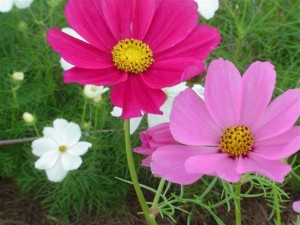Cosmos Six Packs
 Question from Rebecca:
Question from Rebecca:
First of all, I LOVE your month-by-month gardening book–it is the most helpful gardening book in my collection!
Secondly, while cosmos from seed do fine for me, I have had trouble getting them to flourish from six packs. I’ve tried the ones from six packs twice, and they usually stay about the same height they were when I bought them, put out a few pathetic flowers, and die. What do I need to do to help them out? Should I pick off the flowers and buds? I notice the ones I grow from seed don’t put out buds until they are substantial plants but the ones in the six packs come already blooming.
Answer from Pat:
So glad you love my book. It’s sad there are still folks out there who don’t know about it. Sometimes even I can’t make them see how helpful it is.
The cosmos from six packs are often small hybrids that don’t grow tall and aren’t anywhere as good as cosmos from seeds. These hybrid types are “compact”, that is they are like a determinate tomato. They just grow to a certain size bear flowers and seeds, then stop and are done. Also they have been bred to bloom in the pack purely for the sake of nursery gardens who find that plants sell better if they already have flowers on them when the public is looking for plants to purchase. This is not good for the plant however. You are not getting a good garden plant since its energy is put into its salability instead of garden-worthyness.
If more gardeners were educated they would realize that plants in packs that have no blooms are often better than these plants with squashed roots and all energy having gone into popping one pathetic flower on top! if I were you I would plant cosmos from seeds only and not from pony packs. Same with zinnias and stock.
Tall cosmos just grow and bloom like mad all season. Deadheading helps all cosmos bloom longer but I’m with you! I don’t have luck with the little ones in packs and I have not had good luck with any of the compact-sized cosmos. That said, it is very important to loosen the roots of all plants out of pony packs when you plant them. Many times those roots have been so constricted in the pack they never get out there in the ground. So just fondle the roots a little before planting and don’t buy plants that are already too rootbound. I have covered this on some of my videos on this website so folks can see how to loosen the roots. I might make a new videao on that subject sometime.


How nice of you to respond so quickly and in such detail!
I hope my little ‘rubenza’ cosmos are not doomed–I did squish them
about and pick off some of the matted roots at the bottom before
sticking them in the ground yesterday, so I suppose they have the best
chance they can. Perhaps I will pick the buds off to see if I can
‘reprogram’ them to focus on growth instead of responding to whatever
bloom-enhancers they were treated with at the greenhouse…
However, I’m not too hopeful–your comments exactly describe what my
‘cherry profusion’ zinnias are doing right now; they’re supposed to
get to 12 inches tall and 15 wide, but they’re malingering along at
about the same size they were when I planted them from the six pack.
Again, thanks so much for the extremely speedy and thoughtful answers!
I doubt your plants were treated with anything in the greenhouse. It’s all a matter of how the
hybrid is programmed. Pinching off the flowers is not likely to be helpful. I would just go ahead
and feed them and water them and let them be what they are. Next time plant a better variety.
‘Cherry Profusion’ is a good variety of dwarf zinnia, however. You planted your zinnias a little too early.
They do better when planted in May. They need hot weather and hate cold nights. If you read my book
on zinnias you will see that I prefer the tall varieties and I plant them from seeds in warm weather of late spring. ‘Benary’s Giant’ is my favorite variety and Parks Seeds sells it as ‘Parks Best’ but many other catalogues carry Benary’s which was developed for the cut flower trade. (See page 191 of my book for more on zinnias. The index gives many other citations to additional help with zinnias.)